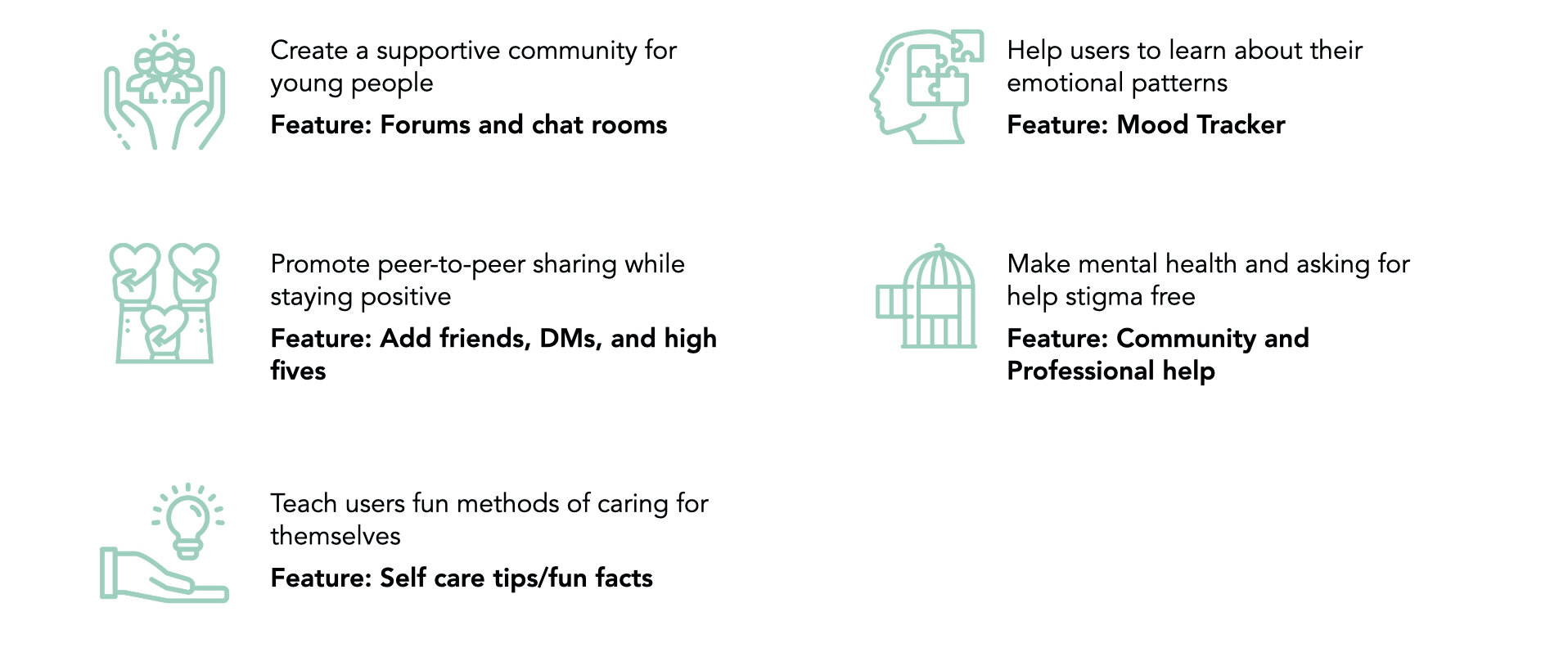Ditto: mental health app
Overview
Depression and suicide rate among young people from ages 15–24 is increasing at an alarming rate. We were inspired to help solve this critical problem by creating a concept app focused on self care and mental health for young people.
My Role:
Concept, UX/UI designer, and Scrum master
Platform:
Native mobile app
Year:
Spring 2020
The Challenge
Young people feel overwhelmed and helpless when dealing with the stressors and pressures of everyday life especially during transitional periods in their lives. They need a safe and supportive way to learn how to deal with these challenges.
How might we support young people in learning healthy and effective ways to cope with their emotions?
The Outcome
Through our research and iterative design process, we landed on a native mobile app, Ditto, to address young people’s emotional wellness needs. Ditto is a safe and fun space to track and vent emotions while receiving the support young people need in an app based community. We also identified Teen Vogue as a potential business partner to help expand the impact of Ditto.
UX Process
Our ux process centers around research, design, and validation to ensure that we’re designing the right things before designing the things right.
Problem Space
Recent research shows that as many as one in five young people suffer from depression and almost 5,000 young people commits suicide every year due to depression. (Source:Mental Health America) Today’s young people face unrealistic academic, social, and family expectations that can cause an overwhelming amount of stress that often leads to depression or even suicide. Therefore, it’s extremely important that young people receive guidance and emotional support as they go through emotional, physical, and life changes.
Business Partner
We identified Teen Vogue as a potential business partner to help us empower more young people with a tool that can help and strengthen their mental health without the stigma.
Why?
Teen Vogue and Ditto share the same mission of educating and inspiring young people to better themselves. Together, we can make mental health stigma free for millions of young people while guiding them through their own self care goals.
How?
Teen Vogue will amplify their goal of empowering their audience by providing them tools for mental health support. Ditto will be able to utilize Teen Vogue's social influence to reach an unique and focused user base.
User Research
To gain an understanding of how young people currently maintain and strengthen their mental health, we conducted five interviews with potential users. We asked them questions around how they cope with stress, what they do as a form of self care, and how they vent their emotions to gain insight into how to better serve their needs.
Insights
Typical User
Bay is a representation of our target demographics. We used her as our reference point in our design decisions.
Bay just graduated from high school and is a prospective student at Parsons. She’s experiencing a lot of mixed emotions as she transitions to the next stage of her life. She is in need of a safe and supportive place to commiserate with her peers.
Journey map
To empathize with Bay, we envisioned a day in Bay’s life as she learns about what her college life might look like from social media platforms. This helped us to examine each emotional state of Bay’s journey and allowed us to see the potential opportunity in expressing and coping with negative emotions.
Goals and Features
Informed by research takeaways, we summarized the user needs below as our goals and corresponding solutions we’d like to implement as features in our app.
Design process
We approached design with an iterative process where each team member contributes, receives feedback, and revises design under a time constraint. We then synthesize the common design elements to create the low-fidelity prototype and continuously to iterate into the mid-fi and hi-fi prototypes based on user feedback.
Key features
For the final prototype, we built out the below key features
Mood tracker for inputting daily emotions
2. Topic based chat forums for peer to peer sharing and support
3. High fives feature that allows users to send and receives high fives
4. Professional support page
5. Direct messages and interactions with buddies in the community
Design language
Ditto verbalizes a sense of companionship and community while being friendly and casual.
Colors signify a lighthearted and positive mood
Avatars provide privacy and equality, while being fun!
Rounded edges of graphics make the app more friendly
Design validation
Feedback
Users enjoyed tracking their mood
"Did you know..." suggestions were helpful
The chats were a supportive place to commiserate
The icons and locations of features were intuitive
The overall app experience brought delight
We conducted two rounds of usability testing on the mid-fi and hi-fi prototypes to validate our design choices, test the overall usefulness, and received feedback on the delightfulness of the user experience. The participants were young people (ages 16-24) that experienced stress and may or may not have sought mental health help from professionals. We gave each user a set of scenarios and tasks to complete. All users were able to complete the requested tasks successfully.
APIs
We would like to imbed a few core technologies within the app to make a more diverse and usable experience for the user.
Next steps
Moving forward, we’d like to continue to test and iterate until all of our designs are testing well, implement proposed APIs, and then collaborate with teen vogue to launch Ditto to their market. Post launch, we’d like to use analytic tools, track performance, and prepare for our next design sprint.










